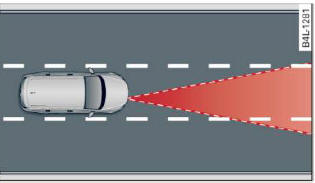Audi Q5: Audi adaptive cruise control
Description
Applies to vehicles: with Audi adaptive cruise control

Fig. 119 Detection range
What can adaptive cruise control do?
The adaptive cruise control works in conjunction with a radar sensor installed in the front of the vehicle > fig. 116, which is subject to designated system limits. Stationary objects are disregarded.
On open roads with no traffic, adaptive cruise control works like a regular cruise control system.
The stored speed is maintained. When approaching a moving vehicle detected up ahead, the adaptive cruise control system automatically slows down to match that vehicle's speed and then maintains the distance that the driver previously stored. As soon as the system does not detect a vehicle up ahead, adaptive cruise control accelerates back up to the stored speed.
Which functions can be controlled?
When you switch adaptive cruise control on, you can set the current speed as the "control speed".
When driving, you can stop cruise control or change the speed at any time.
You can also set the distance to the object ahead and set the adaptive cruise control driving program.

